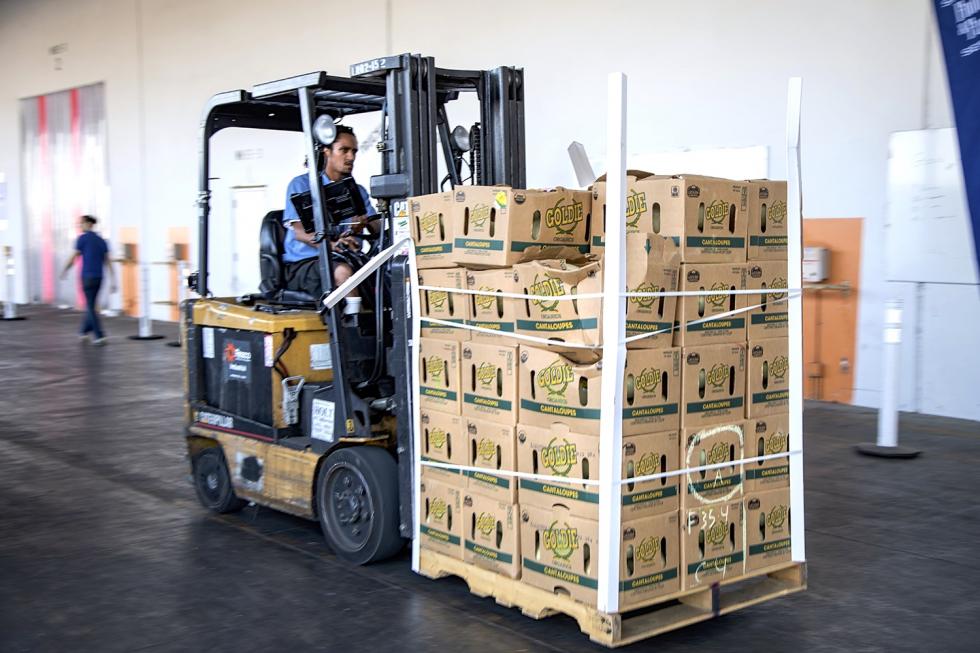After staging a cattle drive across the Tower Bridge and a
tractor parade down Capitol Mall, Mike Testa and his Visit
Sacramento staff faced a huge challenge: How could they broaden
the impact of Sacramento’s Farm-to-Fork Month kickoff?
“When Farm-to-Fork first came out, some of the criticism was that it was high-end,” says Testa, president and CEO of Visit Sacramento, of the Farm-to-Fork Month festivities that launched in 2013. “The reality is that Farm-to-Fork is for everyone.”
To prove his point, Visit Sacramento teamed up with the Sacramento Food Bank and Family Services to set — and break — the world’s record for the most fresh produce contributed in a single day.
Visit Sacramento CEO Mike Testa is interviewed by Gary Gelfand of
FOX40 from the food bank’s North Sacramento warehouse.

On Sept. 6, 23 participating farmers, wholesalers and distributors trucked in 503,071 pounds of fresh produce to the regional food bank warehouse on Bell Avenue in North Sacramento. That breaks the Guinness World Record twice set by this local one-day produce drive — 170,923 pounds in 2015, and 493,977 pounds last year. Testa says he will wait for some other group to break the record before he asks Guinness to re-certify the food bank’s record status.
“In the Sacramento region, we can produce a food drive that no one else can,” Testa says.
Almost as fast as forklifts could bring in the pallets of produce, the food bank was sending it back out to more than 220 partner agencies throughout Sacramento County.
“People are hungry 365 days a year,” says food bank CEO Blake Young, who estimates 240,000 Sacramento County residents — about 17 percent of the total population — may not know where their next meal is coming from. They’re stuck in low-paying jobs, struggling to make ends meet or among a growing number of senior citizens whose fixed income won’t cover expenses.
“It’s deplorable that we have this many people hungry every day,” Young says. “It doesn’t seem right, in the greatest growing region in the country.”
The food bank not only fights hunger; it also fights public misconceptions, beginning with the role of the food bank itself.
Four forklifts worked nonstop to unload more than a half-million
pounds of produce donated to the Sacramento Food Bank and Family
Services.

Following a December 2014 merger with Senior Gleaners, the Sacramento Food Bank has become the regional food banking hub — sourcing, storing and supplying food for its partner agencies throughout the county. Last year, its Food Bank Services division distributed 21.9 million pounds of food, including 6.5 million pounds of fresh produce, to provide an estimated 18 million meals.
More than 220 partner agencies distribute the food in their neighborhoods. Many are located at churches or nonprofit agencies like the Cordova Community Food Locker, Loaves and Fishes, Powerhouse Ministries and Real Life Church of Galt. The South Sacramento Interfaith Partnership, which is supported by 14 area churches, has operated a “food closet” for 48 years at Bethany Presbyterian Church on 24th Street.
“The produce drive just means everything to us” says SSIP Food Closet Manager Lori Sugar. “We serve over 5,000 people every month, and we are dedicated to increasing the nutritional value of the food that we provide. Fresh produce is at the top of our list.”
On the morning after the produce drive, Sugar picked up 1,700 pounds of fresh produce from the regional food bank warehouse. This “bonanza,” she says, will allow her to double the amount of produce SSIP provides to each family.
Blake Young, CEO of the Sacramento Food Bank & Family Services.

The single-day produce drive is just one of the changes Young has witnessed as leader of the food bank for the past 20 years.
“In the old days, we were in the begging business with all donated product,” Young says. “Now, regional food banks like ours are focused on access to fresh and healthy food. We still receive donations, but we also buy a lot of our food.”
As part of the Sept. 6 event, the food bank encouraged the community to donate money that will be used to buy fresh produce when supplies are low. Individual pledges came in via the food bank website and a FOX40 telethon, which included live reports from the food bank’s 100,000-square-foot warehouse in North Sacramento. But the biggest single fundraiser will come on Thanksgiving Day, when nearly 30,000 runners will raise an estimated $1 million in the 24th annual Run to Feed the Hungry.
In addition to its regional food banking operations, the local food bank serves clients directly by providing food, clothing and family services at 3333 3rd Ave. in Oak Park. This Family Services division serves thousands of individuals through ESL programs, GED tutoring, a tech lab, parenting workshops, child care, immigration legal services and even a refugee resettlement program.
“What makes us unique is family services,” Young says. “No other regional food bank offers that. But we believe it’s important to offer programs meant to move people out of the food line. We would love to put ourselves out of business.”
The organization’s goal is to reduce hunger in Sacramento County by 10 percent by 2020. Considering that the hunger rate hasn’t really moved in a decade, that’s an audacious goal.
“There’s a crisis in Sacramento County with the food insecure number,” Young says. “There are so many people so close to being in a more dire situation. They’re half a paycheck away from being homeless.”
Increasing advocacy and outreach is part of the solution, Young believes. Improving organization and leadership is also on the agenda. For example, his team has mapped the 220 food distribution agencies into 13 districts across Sacramento County. Stakeholder meetings address issues such as volunteer management and community outreach. In some cases, agencies may be operating on weekdays, but the local food-insecure population needs access on evenings or weekends.
Young remains optimistic, even while he notes the irony of a 1-in-6 hunger rate in the country’s largest food-growing region. He poses a not-so-rhetorical question: “Since we’re the Farm-to-Fork Capital of America, wouldn’t it be great if Sacramento County were the first hunger-free community?”



